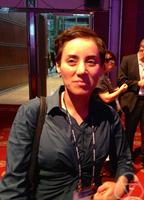Maryam Mirzakhani

Maryam Mirzakhani (May 12, 1977 – July 14, 2017) was an Iranian mathematician.
She worked at Stanford University.[1][2][3] Her research topics include Teichmüller theory, hyperbolic geometry, ergodic theory, and symplectic geometry.[4]
On 13 August 2014, Mirzakhani became both the first woman and the first Iranian honored with the Fields Medal, the most prestigious award in mathematics.[5]
On 14 July 2017, Mirzakhani died of breast cancer at the age of 40.[6]
Background
[change | change source]Mirzakhani was born in May 1977 in Tehran, Iran. She enjoyed math and puzzles in high school. She earned her bachelor's degree at the Sharif University of Technology in Tehran. Mirzakhani then went to Harvard to earn a Ph.D. in 2004.
In high school, Mirzakhani found her talents in math. She decided to reconsider her career goals. This was made possible by her principal. Her principal tried to give women the same chances as men to succeed.[7]
Mirzakhani was also given extra math assignments, which gave her access to university laboratories. She was also allowed to study by herself in the library. This privilege was only given to a few people.[7]
Mirzakhani was diagnosed with breast cancer in 2013.[8] She died of the cancer on July 14, 2017 in Palo Alto, California, aged 40.[9]
Accomplishments
[change | change source]Mirzakhani won the Fields Medal award, the highest mathematical award, in 2014 for her accomplishments in math. She won this award because of her work on Riemann surfaces, a complex mathematical subject. Her work on this subject has improved the basics of both mathematics and physics.[7][10]
Mirzakhani proved multiple relationships between moduli spaces, classes of Riemann surface structures. Her talent led her to be selected twice for the Math Olympiad Team.[7]
Girls had never been part of the Iranian Math Olympiad team. Mirzakhani was the first woman to be on the team and was selected two times in a row. She won gold medals for her team. In 1994, she only had one point taken off and in 1995, she had a perfect score. This was a big accomplishment since she was the first Iranian to do so.[7]
Jobs/roles
[change | change source]Mirzakhani has worked as a math teacher at Princeton University and Stanford University. At Stanford, her interests changed a little. Mirzakhani still worked on geometry and symmetry but started to focus more on theories on Teichmiller dynamics, advanced geometric strategies. Her research was deemed as mathematical research into nature's abstract concepts.[7]
Related pages
[change | change source]References
[change | change source]- ↑ Mirzakhani, Maryam (2007). "Weil-Petersson volumes and intersection theory on the moduli space of curves" (PDF). Journal of the American Mathematical Society. 20 (1): 1–23. Bibcode:2007JAMS...20....1M. doi:10.1090/S0894-0347-06-00526-1. MR 2257394. S2CID 28255159.
- ↑ Mirzakhani, Maryam (January 2007). "Simple geodesics and Weil-Petersson volumes of moduli spaces of bordered Riemann surfaces". Inventiones Mathematicae. 167 (1). Springer-Verlag: 179–222. doi:10.1007/s00222-006-0013-2. ISSN 1432-1297. S2CID 44008647.
- ↑ "Report of the President to the Board of Trustees". Stanford University. 9 April 2008. Retrieved 12 August 2014.
- ↑ Mirzakhani, Maryam. "Curriculum Vitae" (PDF). Archived from the original (PDF) on 24 November 2005. Retrieved 13 August 2014.
- ↑ "President Rouhani Congratulates Iranian Woman for Winning Math Nobel Prize". Fars News Agency. 14 August 2014. Archived from the original on 26 December 2018. Retrieved 14 August 2014.
- ↑ "Maryam Mirzakhani's Pioneering Mathematical Legacy". The New Yorker. 17 July 2017. Archived from the original on 17 July 2017. Retrieved 18 July 2017.
- ↑ 7.0 7.1 7.2 7.3 7.4 7.5 "Maryam Mirzakhani." Encyclopedia of World Biography, vol. 36, Gale, 2016. Student Resources in Context,link.galegroup.com/apps/doc/K1631010503/SUIC?u=palo8 8030&xid=597ed2b0. Accessed 31 Mar. 2017.
- ↑ "Iranian math genius battles cancer recurrence at US hospital".
- ↑ "Maryam Mirzakhani "died"" (in Persian). Mehr news Agancy. 15 July 2017.
- ↑ Kenis, Daniel. "Mirzakhani, Maryam." World Book Advanced. World Book, 2017. Student Resources in Context. Accessed 29 Mar. 2017.
